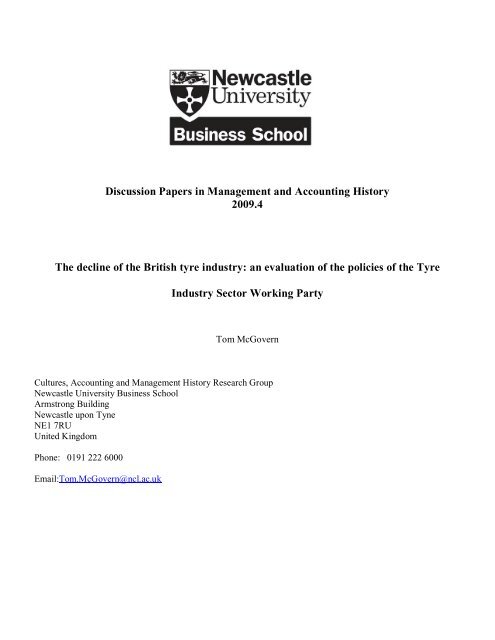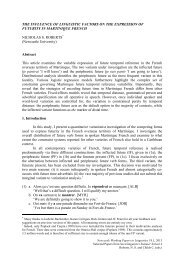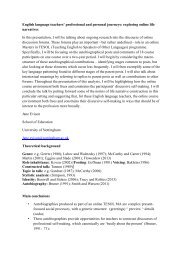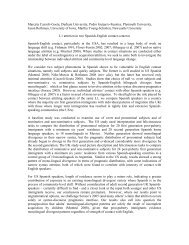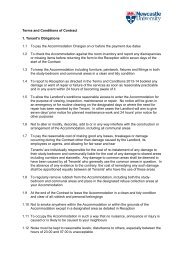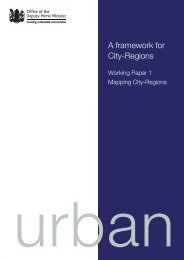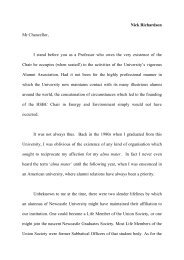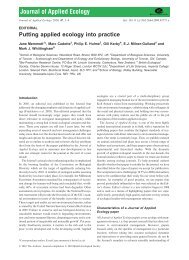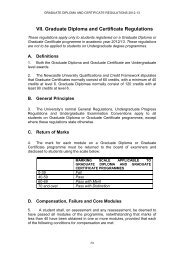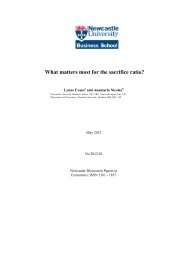The decline of the British tyre industry - Newcastle University
The decline of the British tyre industry - Newcastle University
The decline of the British tyre industry - Newcastle University
You also want an ePaper? Increase the reach of your titles
YUMPU automatically turns print PDFs into web optimized ePapers that Google loves.
Discussion Papers in Management and Accounting History<br />
2009.4<br />
<strong>The</strong> <strong>decline</strong> <strong>of</strong> <strong>the</strong> <strong>British</strong> <strong>tyre</strong> <strong>industry</strong>: an evaluation <strong>of</strong> <strong>the</strong> policies <strong>of</strong> <strong>the</strong> Tyre<br />
Industry Sector Working Party<br />
Tom McGovern<br />
Cultures, Accounting and Management History Research Group<br />
<strong>Newcastle</strong> <strong>University</strong> Business School<br />
Armstrong Building<br />
<strong>Newcastle</strong> upon Tyne<br />
NE1 7RU<br />
United Kingdom<br />
Phone: 0191 222 6000<br />
Email:Tom.McGovern@ncl.ac.uk
Abstract<br />
<strong>The</strong> Labour Government <strong>of</strong> 1974-1979 formulated <strong>the</strong> Industrial Strategy to transform Britain’s industrial<br />
performance. Sector working parties were established to assist companies to become more efficient. <strong>The</strong><br />
paper examines <strong>the</strong> policy response <strong>of</strong> <strong>the</strong> Tyre Industry SWP to overcapacity and declining competitiveness<br />
in <strong>the</strong> <strong>industry</strong>. Policy solutions focused on implementing ‘efficiency dialogues’ to increase output and<br />
efficiency underpinned by job security. Discussions on strategic issues were constrained by <strong>the</strong> multi-<br />
national structure <strong>of</strong> <strong>the</strong> <strong>industry</strong>. This restricted <strong>the</strong> work <strong>of</strong> <strong>the</strong> SWP to communication and employee<br />
involvement. It confirms <strong>the</strong> difficulty <strong>of</strong> reforming <strong>the</strong> existing institutional arrangements to legitimise<br />
company-level interventions.<br />
Key words: Industrial Strategy, sector working party, <strong>tyre</strong> <strong>industry</strong>, <strong>industry</strong> <strong>decline</strong><br />
Introduction<br />
During <strong>the</strong> post-war period a growing concern <strong>of</strong> <strong>British</strong> governments was relative economic <strong>decline</strong> and loss<br />
<strong>of</strong> competitiveness in domestic and world markets. Manufacturing output and productivity grew slower than<br />
in o<strong>the</strong>r major industrial economies as Britain’s industries suffered a declining share in world trade. 1<br />
However, analysis and diagnosis rarely resulted in <strong>the</strong> development and implementation <strong>of</strong> effective policy<br />
measures. 2 <strong>British</strong> industrial policy was described as seeking a ‘convincing rationale’ 3 and interventions were<br />
‘ad hoc, sporadic and incoherent’. 4 Fur<strong>the</strong>r, <strong>the</strong> policy instruments and administrative machinery available to<br />
successive governments were ‘voluntaristic and constrained by <strong>the</strong> imperatives <strong>of</strong> macro-economic policy’. 5<br />
This inhibited <strong>the</strong> development <strong>of</strong> effective micro policies to assist specific industries and companies. 6
According to McKay and Grant <strong>the</strong> implementation <strong>of</strong> a coherent industrial strategy depends on certain<br />
socio/political conditions: (i) an acceptance among political elites that <strong>the</strong> government should play an active<br />
role in assisting <strong>industry</strong> to adapt to change; (ii) good communications between political/bureaucratic and<br />
economic actors and an acceptance by investors <strong>of</strong> <strong>the</strong> need for government intervention. 7 Industrialisation<br />
occurred in Britain before <strong>the</strong> formation <strong>of</strong> a modern state and this contributed to <strong>the</strong> ‘deep ambivalence<br />
about <strong>the</strong> role <strong>of</strong> government in relation to <strong>industry</strong>’. 8 <strong>The</strong> dominant paradigm in <strong>British</strong> industrial policy has<br />
been <strong>the</strong> principle <strong>of</strong> consent and <strong>the</strong> autonomy <strong>of</strong> <strong>the</strong> firm. 9 This produced a ‘continual tension’ between<br />
proponents <strong>of</strong> dirigiste measures to tackle <strong>decline</strong> and advocates <strong>of</strong> liberal solutions. 10 <strong>The</strong> <strong>British</strong> state acts<br />
as Pontius Pilate, not a Bismark. 11 Industrial policy has been determined by ‘<strong>the</strong> state’s inability to coerce <strong>the</strong><br />
private sector’. 12 <strong>British</strong> governments were unwilling to confront <strong>the</strong> vested interest groups in <strong>the</strong> economy<br />
to improve competitiveness. 13 Some economic historians attributed Britain’s relative <strong>decline</strong> to ‘institutional<br />
sclerosis’, 14 whilst o<strong>the</strong>rs viewed <strong>the</strong>se institutional structures as a ‘retardative influence’ ra<strong>the</strong>r than an<br />
insurmountable constraint on growth. 15 On <strong>the</strong> continent industrial progress was nurtured by a partnership<br />
between government and <strong>industry</strong> whereas Britain ‘relied on markets, not institutions’. Proponents <strong>of</strong><br />
dirigisme argued that resolving <strong>the</strong> underlying productivity problems in Britain required <strong>the</strong> ‘visible hand <strong>of</strong><br />
co-ordinated control, not <strong>the</strong> invisible hand <strong>of</strong> <strong>the</strong> self-regulating market’. 16<br />
<strong>The</strong> purpose <strong>of</strong> this article is to explore <strong>the</strong> impact on <strong>the</strong> <strong>tyre</strong> <strong>industry</strong> <strong>of</strong> <strong>the</strong> 1974-1979 Labour<br />
Government’s Industrial Strategy. This was a ‘planning model’ which included consensus policy formulation<br />
by government, business and trade unions. 17 <strong>The</strong> selective intervention policy was launched at a special<br />
National Economic Development Council (NEDC) meeting at Chequers on 5 November 1975. <strong>The</strong> White<br />
Paper entitled An Approach to Industrial Strategy stated that <strong>the</strong> prime objective was to transform Britain<br />
into ‘a high output, high wage economy……by improving our industrial performance and raising <strong>the</strong> growth<br />
<strong>of</strong> our productive potential’. 18 <strong>The</strong> government held it to be <strong>the</strong> responsibility <strong>of</strong> management and unions to<br />
deliver higher productivity. 19 A new structure <strong>of</strong> sector working parties (SWPs) was established to augment<br />
<strong>the</strong> original economic development committees (EDCs). <strong>The</strong> objective <strong>of</strong> <strong>the</strong> EDCs and SWPs was to help
companies in <strong>the</strong>ir sectors to become more efficient and thus increase <strong>the</strong>ir share <strong>of</strong> domestic and world<br />
markets. 20 This differed from previous indicative planning ins<strong>of</strong>ar that <strong>the</strong> government and <strong>the</strong> NEDC were<br />
proposing ‘to build up from <strong>the</strong> bottom on <strong>the</strong> basis <strong>of</strong> what was possible and not impose targets from<br />
above’. 21 Politically, <strong>the</strong>se new bodies performed an additional function <strong>of</strong> helping <strong>the</strong> government to steer a<br />
course between Tony Benn 22 and his supporters who backed planning agreements and <strong>the</strong> CBI which<br />
opposed <strong>the</strong>m. <strong>The</strong> setting up <strong>of</strong> <strong>the</strong> SWPs was ‘a means <strong>of</strong> appearing to institute planning agreements<br />
without doing much about <strong>the</strong>m or risking breaking up <strong>the</strong> machinery <strong>of</strong> NEDC tripartism’. 23 One critic<br />
described <strong>the</strong> Industrial Strategy as ‘not so much a strategy, more an empty slogan’. 24<br />
<strong>The</strong> strategy emphasised ‘picking winners’, 25 although in reality it was more indiscriminate. 26 <strong>The</strong> Director<br />
General <strong>of</strong> <strong>the</strong> NEDO described <strong>the</strong> SWPs as <strong>the</strong> ‘basic mechanism’ 27 underpinning <strong>the</strong> Industrial Strategy.<br />
Some 39 SWPs operating by consensus and tailored to specific industries were created encompassing 40 per<br />
cent <strong>of</strong> manufacturing output. 28 Some were new while o<strong>the</strong>rs, including <strong>the</strong> Rubber Processing SWP<br />
(renamed <strong>the</strong> Tyre Industry SWP in 1980), 29 were formed from existing EDCs. <strong>The</strong> emphasis was on<br />
developing policy oriented strategic plans ra<strong>the</strong>r than detailed numerical plans, which mirrored <strong>the</strong> approach<br />
adopted by companies. 30 Inevitably, SWPs were established in sectors which had a powerful trade<br />
association, or where <strong>the</strong>re were strong links with <strong>the</strong> sponsoring department in <strong>the</strong> Department <strong>of</strong> Industry. 31<br />
<strong>The</strong> effectiveness <strong>of</strong> <strong>the</strong> SWP system as an instrument <strong>of</strong> industrial regeneration ‘has received surprisingly<br />
little critical attention’. 32 <strong>The</strong> SWPs could have played a vital role in <strong>the</strong> creation <strong>of</strong> an effective micro<br />
strategy by addressing problems confronting <strong>the</strong>ir respective industries. <strong>The</strong> limited empirical research<br />
identified <strong>the</strong> critical lack <strong>of</strong> any mechanism for securing <strong>the</strong> implementation <strong>of</strong> SWP policies at <strong>the</strong> level <strong>of</strong><br />
<strong>the</strong> firm. 33 This article will evaluate <strong>the</strong> policy response <strong>of</strong> <strong>the</strong> Rubber Processing/Tyre Industry SWP to<br />
overcapacity and <strong>the</strong> declining competitiveness <strong>of</strong> <strong>the</strong> <strong>British</strong> <strong>tyre</strong> <strong>industry</strong>. It will explore <strong>the</strong> development<br />
<strong>of</strong> ‘efficiency dialogues’ and <strong>the</strong> difficulties <strong>of</strong> implementing this policy. <strong>The</strong> paper will examine <strong>the</strong>
institutional constraints that impacted on <strong>the</strong> policies <strong>of</strong> <strong>the</strong> Rubber Processing/Tyre Industry SWP to explain<br />
why its work became narrowly focused on communication and employee involvement.<br />
<strong>The</strong> objectives <strong>of</strong> <strong>the</strong> Rubber Processing SWP<br />
<strong>The</strong> Rubber Processing SWP contained representatives from <strong>the</strong> <strong>tyre</strong> companies with operations in Britain:<br />
Avon, Dunlop, Firestone, Goodyear, Michelin, Pirelli and Uniroyal. <strong>The</strong> management representatives were<br />
usually a chairman or managing director or, at <strong>the</strong> very least, a director or senior divisional executive. <strong>The</strong><br />
trade unions were led by John Miller, <strong>the</strong> National Secretary <strong>of</strong> <strong>the</strong> Transport and General Workers Union.<br />
All <strong>of</strong> <strong>the</strong> union representatives, with one exception, were area, regional or national <strong>of</strong>ficers. 34 <strong>The</strong> o<strong>the</strong>r<br />
members were from <strong>the</strong> <strong>British</strong> Rubber Manufacturers Association (BRMA), <strong>the</strong> Rubber and Plastics<br />
Processing Industry Training Board (RPPITB), <strong>the</strong> Department <strong>of</strong> Industry and <strong>the</strong> NEDO. <strong>The</strong> chairman<br />
was John Cousins, Personnel Director at Plessey and an ex full-time <strong>of</strong>ficial <strong>of</strong> <strong>the</strong> Transport and General<br />
Workers’ Union. 35<br />
<strong>The</strong> rubber <strong>industry</strong> products are components for o<strong>the</strong>r manufacturers’ end products, in particular <strong>the</strong> motor<br />
<strong>industry</strong>. <strong>The</strong> <strong>tyre</strong> sector comprises two distinct market segments: original equipment and replacement sales.<br />
<strong>The</strong> former accounts for 25 per cent <strong>of</strong> <strong>the</strong> <strong>British</strong> producers total sales, and is characterised by direct, large<br />
volume transactions with <strong>the</strong> vehicle assemblers. <strong>The</strong> latter is about 2.5 times larger in volume and involves<br />
sales to vehicle owners to replace worn-out <strong>tyre</strong>s. 36<br />
inelastic and is determined by <strong>the</strong> number <strong>of</strong> vehicles produced.<br />
<strong>The</strong> demand for original equipment <strong>tyre</strong>s is price<br />
In 1972 new car registrations in Britain reached a peak <strong>of</strong> 1.7 million and production similarly peaked at 1.9<br />
million cars. <strong>The</strong> oil crisis in 1973-1974 caused demand and production to fall in unison, but as demand<br />
picked up production continued to <strong>decline</strong>, so that by 1977 new registrations had outstripped production. In
1973 Britain joined <strong>the</strong> EEC and in July 1977 duty on Community imports was removed, which allowed <strong>the</strong><br />
continental producers to exploit <strong>the</strong> <strong>British</strong> market. <strong>The</strong> elimination <strong>of</strong> tariffs was not <strong>the</strong> sole cause <strong>of</strong> <strong>the</strong><br />
increase in imports. <strong>The</strong> <strong>British</strong> car <strong>industry</strong> had a legacy <strong>of</strong> uncompetitive plant and an ageing model range<br />
due to <strong>the</strong> lack <strong>of</strong> investment in <strong>the</strong> 1960s. 37 <strong>The</strong> oil crisis caused a shift in demand away from large-engine<br />
cars and by 1974 cars with an engine capacity <strong>of</strong> less than 1200cc accounted for 25 per cent <strong>of</strong> total sales. 38<br />
<strong>The</strong> foreign assemblers were able to meet this demand whereas <strong>the</strong> <strong>British</strong> producers were unable to respond.<br />
As a consequence, original equipment <strong>tyre</strong> production fell from a peak <strong>of</strong> nearly 11 million car <strong>tyre</strong>s in 1972<br />
to under 6 million in 1975. 39<br />
<strong>The</strong> second strategic issue facing <strong>the</strong> <strong>tyre</strong> manufacturers was <strong>the</strong> shift away from <strong>the</strong> crossply to <strong>the</strong> longer<br />
wearing radial <strong>tyre</strong>. <strong>The</strong> spread <strong>of</strong> <strong>the</strong> fabric belted radial in <strong>the</strong> <strong>British</strong> original equipment and replacement<br />
markets coincided with <strong>the</strong> oil crisis. <strong>The</strong> cutback in vehicle mileage combined with <strong>the</strong> longevity <strong>of</strong> <strong>the</strong><br />
radial caused <strong>the</strong> replacement market to dramatically shrink in size. <strong>The</strong> <strong>industry</strong> was fur<strong>the</strong>r depressed by<br />
<strong>the</strong> adoption <strong>of</strong> <strong>the</strong> steel radial in 1975 which captured 38 per cent and 25 per cent respectively <strong>of</strong> <strong>the</strong> original<br />
equipment and replacement markets. 40 <strong>The</strong> feasible life <strong>of</strong> a crossply <strong>tyre</strong> was 18,000 miles compared to<br />
28,000 miles for a fabric radial and 40,000 miles for a steel radial. 41 As a result, car <strong>tyre</strong> production slumped<br />
from 26.64 million units in 1970 to 22.22 million in 1975. 42<br />
In 1977 <strong>the</strong> Rubber Processing SWP set itself <strong>the</strong> task <strong>of</strong> arresting and reversing <strong>the</strong> <strong>decline</strong> <strong>of</strong> <strong>the</strong> <strong>British</strong><br />
<strong>tyre</strong> sector. <strong>The</strong> SWP identified two key policies: first, to improve domestic production efficiency; second, to<br />
increase <strong>the</strong> producers’ sales and marketing efforts. <strong>The</strong> SWP’s guiding principle was that improving<br />
performance should be underpinned by security <strong>of</strong> employment, and that increases in productivity should be<br />
determined by increased output and a higher world market share. 43<br />
<strong>The</strong> NEDO quantified <strong>the</strong> target output level from market forecasts and productivity data provided in<br />
confidence by individual companies. <strong>The</strong> information suggested that <strong>British</strong> productivity (measured by
weight <strong>of</strong> throughput per man hour) needed to increase on average by 30 per cent to match international<br />
standards. 44 If this target was achieved, an average 30 per cent more capacity would be needed to absorb <strong>the</strong><br />
surplus workforce and guarantee security <strong>of</strong> employment. 45<br />
<strong>The</strong> NEDO estimated that a fur<strong>the</strong>r 20 per cent<br />
production increase could be obtained from more intensive use <strong>of</strong> existing plant. <strong>The</strong>refore, to guarantee<br />
security <strong>of</strong> employment an increase in production <strong>of</strong> 50 per cent might be required.<br />
Discussions in <strong>the</strong> SWP suggested that <strong>the</strong> prospects <strong>of</strong> increasing production over <strong>the</strong> following five years<br />
were good providing efficiency increased, but ‘forecast market growth was insufficient to support guarantees<br />
<strong>of</strong> secure employment’. 46 A subsequent policy document was more conservative and focused on increasing<br />
domestic production by up to 18 per cent from <strong>the</strong> current level <strong>of</strong> 32 million <strong>tyre</strong>s. Relative production<br />
efficiency would still need to increase by up to 30 per cent. However, <strong>the</strong> reduction in unit costs and <strong>the</strong><br />
planned increase in production were premised on more intensive plant utilisation and selective investment. 47<br />
Security <strong>of</strong> employment was dependent on increasing efficiency and sales. 48<br />
<strong>The</strong> SWP identified increasing exports as one way <strong>of</strong> expanding production and sustaining domestic<br />
employment. An analysis <strong>of</strong> <strong>the</strong> global competitive position showed that <strong>British</strong> <strong>tyre</strong> exports were<br />
concentrated in <strong>the</strong> Commonwealth and <strong>the</strong> developing world, whilst penetration <strong>of</strong> European and North<br />
American markets was notably shallow. Europe was identified as a prime target for export led growth<br />
because it was a production intensive market with a high degree <strong>of</strong> international sourcing, and established<br />
distribution channels. 49 Increased efficiency would enable <strong>the</strong> domestic producers to reduce <strong>the</strong>ir unit costs<br />
and gain a larger share <strong>of</strong> <strong>the</strong> European market. 50<br />
<strong>The</strong> SWP also canvassed <strong>the</strong> government to encourage <strong>the</strong> Japanese car manufacturers to establish operations<br />
in Britain. This would potentially increase original equipment production by 2.6 million <strong>tyre</strong>s. 51 <strong>The</strong><br />
combination <strong>of</strong> this extra output with <strong>the</strong> 30 per cent productivity improvement target implied a contraction
in <strong>the</strong> workforce from 40,000 to about 34,000 in 1981. <strong>The</strong> NEDO estimated that this reduction could be<br />
achieved through ‘natural wastage’ while guaranteeing secure employment for <strong>the</strong> remaining employees. 52<br />
Efficiency Dialogues<br />
<strong>The</strong> SWP’s strategy to increase output and efficiency and simultaneously guarantee job security was to be<br />
achieved through <strong>the</strong> mechanism <strong>of</strong> ‘efficiency dialogues’. To initiate this strategy, J Walter Thompson was<br />
engaged in 1978 to develop a communications programme for <strong>the</strong> <strong>industry</strong>. <strong>The</strong> objectives <strong>of</strong> this programme<br />
were: (i) to extend <strong>the</strong> dialogue beyond <strong>the</strong> SWP; (ii) to inform employees about <strong>the</strong> world outside <strong>the</strong><br />
factory; and (iii) to reinforce <strong>the</strong> management and trade unions’ leadership in companies. 53<br />
During visits to <strong>tyre</strong> plants, and after interviewing nearly 100 key opinion formers in <strong>the</strong> <strong>industry</strong>, <strong>the</strong><br />
consultants received feedback from <strong>the</strong> shop floor that <strong>the</strong> major cause <strong>of</strong> <strong>the</strong> <strong>industry</strong>’s troubles was cheap<br />
imports from Eastern Europe. 54<br />
Although this viewpoint was incorrect, <strong>the</strong> SWP decided to use this issue to<br />
raise its public pr<strong>of</strong>ile with rank-and-file employees, who were largely unaware <strong>of</strong> its existence. A ‘strongly<br />
worded’ letter was sent by <strong>the</strong> SWP to <strong>the</strong> Secretary <strong>of</strong> State for Trade requesting anti-dumping action and/or<br />
selective controls on imports from Eastern Europe. This letter paved <strong>the</strong> way for <strong>the</strong> first major <strong>tyre</strong> <strong>industry</strong><br />
conference held in Birmingham during November 1978.<br />
<strong>The</strong> aim was to introduce <strong>the</strong> Rubber Processing SWP and to establish its credibility with <strong>the</strong> <strong>industry</strong>’s<br />
major opinion formers. Nearly 400 representatives from all seventeen domestic <strong>tyre</strong> plants, plus government<br />
and trade union <strong>of</strong>ficials attended <strong>the</strong> conference. It was <strong>the</strong> first time that management and unions had<br />
assembled toge<strong>the</strong>r on a multi-plant basis. 55 <strong>The</strong> conference was held ‘amidst rumours <strong>of</strong> plant closures and<br />
redundancies’. 56<br />
<strong>The</strong> delegates unanimously agreed that plant level ‘efficiency dialogues’ was needed to<br />
reverse <strong>the</strong> serious <strong>decline</strong> in competitiveness and employment in <strong>the</strong> <strong>British</strong> rubber <strong>industry</strong>.
<strong>The</strong> SWP proposed a two-pronged attack to improve performance: (i) an aggressive marketing <strong>of</strong><br />
competitively priced <strong>tyre</strong>s; and (ii) more efficient use <strong>of</strong> plant and manpower. 57 This strategy entailed<br />
reducing unit costs to make <strong>the</strong> <strong>British</strong> plants competitive with those in Europe. <strong>The</strong> government argued that<br />
productivity improvements depended only partly on investment and crucially required ‘making better use <strong>of</strong><br />
existing plant and getting higher output (as competitors do) from new buildings and plant’. 58 To achieve<br />
change, <strong>the</strong> SWP suggested that two conditions should be met: (i) those working in <strong>the</strong> <strong>industry</strong> should feel<br />
and be involved in any initiative to achieve higher efficiency; and (ii) workers participating in efficiency<br />
schemes should have assurances on security <strong>of</strong> employment. 59<br />
However, raising productivity in a stagnant<br />
market was incompatible with employment security, and this should have been obvious to <strong>the</strong> SWP. Fur<strong>the</strong>r,<br />
without increased investment, <strong>the</strong> <strong>British</strong> plants could not match <strong>the</strong> efficiency <strong>of</strong> <strong>the</strong> European plants.<br />
Overcapacity was an indicator that <strong>the</strong> older, less efficient <strong>British</strong> factories would close.<br />
<strong>The</strong> SWP advocated that ‘efficiency dialogues’ should be conducted at plant level through existing<br />
consultative committees, or new plant development committees. 60 <strong>The</strong>se committees would not just address<br />
increasing efficiency, but would cover issues beyond joint consultation including marketing strategy,<br />
employment trends, and pr<strong>of</strong>its as <strong>the</strong>y related to <strong>the</strong> plant. 61 <strong>The</strong> SWP suggested that divisional and/or<br />
company level bodies could also be established to discuss <strong>the</strong> financial performance, new legislation,<br />
investment, manpower policies, and market position. It was argued that discussions on <strong>the</strong>se issues would<br />
help to ‘improve <strong>the</strong> quality <strong>of</strong> decisions and would complement <strong>the</strong> decision-making procedure’. 62<br />
composition and procedural arrangements for plant and company-level bodies were to be agreed between<br />
management and unions.<br />
Mr David Warburton, <strong>the</strong> National Officer for <strong>the</strong> rubber and chemical industries at <strong>the</strong> General Municipal<br />
Workers Union, welcomed <strong>the</strong> document. He stressed that greater disclosure <strong>of</strong> information was paramount<br />
to enable <strong>the</strong> exercise to go ahead. In return <strong>the</strong> unions made a commitment to discuss manpower planning.<br />
He warned against any attempts to use ‘efficiency dialogues’ as a ‘sophisticated exercise in indiscriminate<br />
<strong>The</strong>
demanning’. 63<br />
However, with <strong>the</strong> substantial obsolete capacity in <strong>the</strong> home market, it is difficult to see how<br />
increasing efficiency would not be at <strong>the</strong> expense <strong>of</strong> jobs.<br />
Evaluation <strong>of</strong> <strong>the</strong> SWP strategy<br />
<strong>The</strong> SWP acknowledged that it was unable to influence product and investment planning in <strong>the</strong> <strong>industry</strong>. 64<br />
Policy agreements in <strong>the</strong> SWP to increase output and efficiency and guarantee security <strong>of</strong> employment could<br />
not be realised at <strong>the</strong> company or plant level. <strong>The</strong> NEDO advisors were aware <strong>of</strong> this, but it was <strong>the</strong> only way<br />
<strong>of</strong> getting <strong>the</strong> parties to reach an agreement. <strong>The</strong> companies wanted improvements in productivity whilst <strong>the</strong><br />
unions sought job security. Data produced by <strong>the</strong> NEDO revealed that if a 20 per cent increase in efficiency<br />
was to be achieved by 1981, toge<strong>the</strong>r with security <strong>of</strong> employment, import penetration <strong>of</strong> car <strong>tyre</strong>s from <strong>the</strong><br />
EEC would have to be reduced from <strong>the</strong> current level <strong>of</strong> 25 per cent to 2 per cent. 65<br />
This was not feasible!<br />
Insert Table 1 Employment and output in <strong>the</strong> UK <strong>tyre</strong> <strong>industry</strong>, 1973-82<br />
Table 1 shows that in 1981, total <strong>tyre</strong> production (car, truck, bus, earthmover, dumper and tractor) fell to 24.2<br />
million <strong>tyre</strong>s, a considerable way short <strong>of</strong> <strong>the</strong> target <strong>of</strong> 36.3 million <strong>tyre</strong>s, whilst employment had shrunk to<br />
27,700 people compared to <strong>the</strong> target <strong>of</strong> 34,000. 66 <strong>The</strong> net effect <strong>of</strong> <strong>the</strong> reduction in employment was to<br />
increase productivity (output per man) between 1975 and 1981 by 31 per cent. This supports Crafts assertion<br />
that: ‘<strong>The</strong> productivity surge <strong>of</strong> <strong>the</strong> 1980s appears to have owed little to greater investment in plant, people,<br />
or research and development but to have come primarily from more efficient use <strong>of</strong> existing factors <strong>of</strong><br />
production and in effect to have been based on a shake-out <strong>of</strong> inefficiencies which had accumulated in <strong>the</strong><br />
earlier decades’. 67 Six <strong>tyre</strong> plants were closed during this period 68 which contributed to <strong>the</strong> large increase in<br />
productivity. However, <strong>the</strong> fall in employment was insufficient to counteract <strong>the</strong> <strong>decline</strong> in output. Hence
productivity (productivity index) failed to meet <strong>the</strong> target <strong>of</strong> 159 considered by <strong>the</strong> SWP to be necessary to<br />
make <strong>British</strong> <strong>tyre</strong>s competitive at home and overseas. 69<br />
For production to be on course, output per man<br />
should have risen to 1,063 <strong>tyre</strong>s by 1981 compared with an actual figure <strong>of</strong> 875. By implication, employment<br />
in 1981 should have fallen to 22,810 people, as opposed to 27,700 <strong>the</strong>n employed. Clearly, more job losses<br />
were to be expected, and this should have been obvious to <strong>the</strong> SWP representatives.<br />
<strong>The</strong> production targets were not achieved, and hence jobs were lost, because <strong>the</strong> <strong>industry</strong> failed to meet<br />
domestic and export market objectives. <strong>The</strong> SWP set a target for 1981 <strong>of</strong> a positive balance <strong>of</strong> trade with <strong>the</strong><br />
EEC <strong>of</strong> 3,360,000 car <strong>tyre</strong>s and 480,000 truck and bus <strong>tyre</strong>s. 70<br />
In practice, between 1977 and 1979, Britain<br />
suffered a negative trade balance in car <strong>tyre</strong>s as captive and independent distributor imports from <strong>the</strong> EEC<br />
increased sharply from <strong>the</strong> mid-1970s. <strong>The</strong> following year witnessed a steep rise in exports to <strong>the</strong> European<br />
Community, accompanied by a fall-<strong>of</strong>f in imports, which produced a positive balance <strong>of</strong> 1.8 million <strong>tyre</strong>s. A<br />
year later, in 1981, <strong>the</strong> UK recorded a deficit <strong>of</strong> 319,000 car <strong>tyre</strong>s with <strong>the</strong> European Community. <strong>The</strong> trade<br />
in truck and bus <strong>tyre</strong>s fared much better, inasmuch that no deficit was recorded. In 1976 a favourable balance<br />
<strong>of</strong> 325,000 <strong>tyre</strong>s was recorded, but this fell to 8,000 <strong>tyre</strong>s in 1977. <strong>The</strong>re was a steady climb in <strong>the</strong> trade<br />
balance, culminating in a surplus <strong>of</strong> nearly 274,000 truck and bus <strong>tyre</strong>s in 1981; but, it was still 43 per cent<br />
below <strong>the</strong> SWP target. <strong>The</strong>re is little evidence that higher productivity led to substantial improvements in <strong>the</strong><br />
trade balance.<br />
Exports failed to meet <strong>the</strong> SWP targets because <strong>the</strong> policy conflicted with <strong>the</strong> strategies <strong>of</strong> <strong>the</strong> <strong>tyre</strong><br />
companies. During <strong>the</strong> 1960s, <strong>the</strong> <strong>tyre</strong> companies regarded Britain and <strong>the</strong> Continent as two distinct<br />
markets. 71 However, with <strong>the</strong> development <strong>of</strong> <strong>the</strong> European Community, followed by Britain’s entry in 1973,<br />
<strong>the</strong> <strong>tyre</strong> companies viewed Europe as one market, and planned production on that basis. This proved<br />
detrimental to Britain, which was now experiencing poorer economic performance and lower growth than her<br />
European neighbours. As <strong>the</strong> size <strong>of</strong> <strong>the</strong> domestic market started to shrink, owing to <strong>the</strong> oil crisis, <strong>the</strong><br />
displacement <strong>of</strong> <strong>the</strong> crossply by <strong>the</strong> longer lasting steel radial <strong>tyre</strong>, and <strong>the</strong> declining output <strong>of</strong> <strong>British</strong> cars,
<strong>the</strong> <strong>tyre</strong> producers viewed Britain less favourably as a production base. 72 <strong>The</strong> <strong>British</strong> plants were used to<br />
source only <strong>the</strong> home and Commonwealth markets. <strong>The</strong> European producers concentrated <strong>the</strong>ir sales within<br />
<strong>the</strong> European Community and were able to establish a stable base to exploit o<strong>the</strong>r markets. 73<br />
<strong>The</strong> trade union representatives on <strong>the</strong> SWP demanded import controls to protect <strong>the</strong> domestic <strong>industry</strong>. This<br />
conflicted with government strategy which stressed that ‘sectors should aim to compete with imports by<br />
identifying <strong>the</strong> vulnerable product areas and <strong>the</strong> reasons for importing, and not to seek to limit or regulate<br />
imports’. 74 Import controls were contrary to Community membership and also conflicted with <strong>the</strong><br />
manufacturers’ sourcing policies. <strong>The</strong> <strong>tyre</strong> companies were only prepared to support <strong>the</strong> SWP’s anti-dumping<br />
action against ‘disruptive’ imports from Eastern Europe. An agreement was, however, reached to set<br />
voluntary import ceilings to reduce import penetration by 1981 to <strong>the</strong> level pertaining in 1975. 75 This would<br />
allow <strong>the</strong> substitution <strong>of</strong> up to one million imported car and commercial <strong>tyre</strong>s by home production. 76<br />
<strong>The</strong>re was little prospect <strong>of</strong> <strong>the</strong>se targets being met as <strong>the</strong> SWP had no influence on <strong>the</strong> policies <strong>of</strong> <strong>the</strong><br />
producers or <strong>the</strong> independent distributors that imported <strong>tyre</strong>s into Britain. <strong>The</strong> impotence <strong>of</strong> <strong>the</strong> SWP is<br />
shown in table 2. Car and van <strong>tyre</strong> imports’ share <strong>of</strong> <strong>the</strong> replacement market increased from 27 to 42 per cent<br />
between 1975 and 1980 (captive imports increased from 11 to 16 per cent whilst distributor imports<br />
increased from 16 to 26 per cent). 77 After 1977 captive imports displaced home production. 78 Dunlop was<br />
reducing its dependency on <strong>British</strong> production by concentrating investment overseas. Dunlop’s <strong>British</strong> plants<br />
had insufficient steel radial capacity and its European facilities were used to meet <strong>the</strong> shortfall in domestic<br />
supply. 79 <strong>The</strong> NEDO did, however, secure a promise from Dunlop to stop importing East European <strong>tyre</strong>s. 80<br />
Insert Table 2 Import penetration <strong>of</strong> <strong>the</strong> UK net replacement market, 1973-80 (%)
None <strong>of</strong> <strong>the</strong> voluntary targets were met. In 1980, imports <strong>of</strong> car and van <strong>tyre</strong>s exceeded <strong>the</strong> 1981 target by 56<br />
per cent, truck <strong>tyre</strong>s by 95 per cent, tractor <strong>tyre</strong>s by 72 per cent and earthmover/dumper <strong>tyre</strong>s by 88 per cent.<br />
In <strong>the</strong> last two categories, <strong>the</strong> levels <strong>of</strong> imports exceeded <strong>the</strong> size <strong>of</strong> <strong>the</strong> replacement market, indicating <strong>the</strong>y<br />
were also used to source <strong>the</strong> original equipment market. 81 Driver suggested that <strong>the</strong> SWPs produced a<br />
relative improvement in manufacturing import penetration, which he attributed to <strong>the</strong> import substitution<br />
measures that <strong>the</strong>y initiated. 82<br />
<strong>The</strong>re is no evidence that this occurred or was successful in <strong>the</strong> <strong>tyre</strong> sector.<br />
Increases in productivity did not lead to a reduction in imports.<br />
Employee Involvement Programme<br />
Some trade unionists such as Mr Howlett, <strong>the</strong> Engineering Branch Secretary at Firestone, were sceptical <strong>of</strong><br />
<strong>the</strong> SWP’s approach. He argued at Birmingham that <strong>the</strong> <strong>tyre</strong> plants needed investment and modernisation. 83<br />
Two days after <strong>the</strong> conference had finished, Dunlop announced <strong>the</strong> closure <strong>of</strong> its plant at Speke, followed<br />
shortly by <strong>the</strong> announcement that Firestone was withdrawing from Britain. This was a turning point in policy,<br />
with any pretence <strong>of</strong> reversing <strong>the</strong> <strong>tyre</strong> sector’s <strong>decline</strong> now abandoned. <strong>The</strong> SWP was forced to admit that<br />
‘efficiency dialogues’ ‘had not been a great success’. 84<br />
management and <strong>the</strong> shopfloor to confront <strong>the</strong> <strong>industry</strong>’s problems.<br />
A different approach was now needed to force<br />
<strong>The</strong> SWP felt compelled to become directly involved in <strong>the</strong> communication process in each company,<br />
although reservations were raised about using existing communication channels. 85 <strong>The</strong> companies were<br />
content to use <strong>the</strong> SWP leaflets and briefing materials in <strong>the</strong>ir communication programmes. <strong>The</strong>y were less<br />
willing to allow <strong>the</strong> SWP to make presentations in <strong>the</strong>ir plants. Goodyear was persuaded to allow <strong>the</strong> SWP to<br />
address its Wolverhampton workforce in November 1980. This was video-recorded and made available to<br />
employees in <strong>the</strong> plant, although representatives from <strong>the</strong> o<strong>the</strong>r companies were excluded and <strong>the</strong> circulation<br />
<strong>of</strong> <strong>the</strong> video was restricted to Goodyear.
<strong>The</strong> SWP progressed to <strong>the</strong> third stage <strong>of</strong> <strong>the</strong> plan devised by J Walter Thompson. <strong>The</strong> management and<br />
trade union <strong>of</strong>ficials supported ‘efficiency dialogues’ but saw it <strong>of</strong> limited use because <strong>of</strong> ‘<strong>the</strong> lack <strong>of</strong><br />
understanding and knowledge <strong>of</strong> <strong>the</strong> participants’. 86<br />
A solution put forward in May 1981 was an Employee<br />
Involvement Programme aimed at changing <strong>the</strong> attitudes <strong>of</strong> managers, supervisors and shop stewards.<br />
Dunlop agreed to participate in this experiment.<br />
In July 1981, it was agreed that <strong>the</strong> Office should hold informal meetings with <strong>the</strong> management and unions to<br />
implement this programme. <strong>The</strong> trade union representatives raised two matters <strong>of</strong> concern. First, <strong>the</strong>y<br />
objected to <strong>the</strong> programme being funded by <strong>the</strong> government and, second, <strong>the</strong>y were opposed to <strong>the</strong><br />
companies being directly responsible for <strong>the</strong> training <strong>of</strong> both shop stewards and managers. 87<br />
<strong>The</strong> first<br />
problem was tackled by <strong>the</strong> NEDO funding <strong>the</strong> programme. <strong>The</strong> second objection was overcome by <strong>the</strong><br />
engagement <strong>of</strong> Pr<strong>of</strong>essor George Bain, a leading industrial relations researcher at Warwick <strong>University</strong>, to<br />
undertake a feasibility study at Dunlop.<br />
Pr<strong>of</strong>essor Bain was asked to investigate how communication/participation was working at Dunlop; <strong>the</strong> effect<br />
that it had on developing ‘efficiency dialogues’; to identify those issues which required joint discussion and<br />
determination, and to identify <strong>the</strong> information and training needs <strong>of</strong> employees to fur<strong>the</strong>r <strong>the</strong> development <strong>of</strong><br />
<strong>the</strong> participative process. 88<br />
From December 1981 to January 1982, he held meetings with senior group and<br />
divisional management, and shop stewards from all <strong>the</strong> unions represented in <strong>the</strong> plant (rubber workers, staff<br />
and craft). <strong>The</strong> initial meetings were held separately, but eventually joint meetings were held with <strong>the</strong> rubber<br />
workers and staff and, finally with <strong>the</strong>m and senior management. After two initial meetings, <strong>the</strong> craft workers<br />
<strong>decline</strong>d to take any fur<strong>the</strong>r part in <strong>the</strong> project. This was because flexibility had been introduced into <strong>the</strong> craft<br />
areas and was not universally supported by <strong>the</strong>se workers. <strong>The</strong>y did not believe that <strong>the</strong> communications<br />
programme <strong>of</strong>fered any benefits.
Pr<strong>of</strong>essor Bain found that Dunlop had implemented many <strong>of</strong> <strong>the</strong> general proposals outlined in ‘efficiency<br />
dialogues’, including greater labour flexibility, improved quality control, more efficient use <strong>of</strong> plant and<br />
machinery, reduced manning levels and lower costs. Dunlop had devised its own involvement policy using<br />
action learning, briefing and involvement groups to encourage greater employee commitment to business<br />
objectives, and to improve overall effectiveness. 89 However, Bain reported that <strong>the</strong> unions were ‘dissatisfied<br />
with <strong>the</strong> company’s involvement policy’, 90 because it emphasised ‘communication ra<strong>the</strong>r than consultation’,<br />
or to quote one shop steward ‘management decides and we listen’. 91<br />
<strong>The</strong> stewards stated that <strong>the</strong>y required more finance information: group and divisional pr<strong>of</strong>it levels, <strong>the</strong><br />
budgeting process and <strong>the</strong> extent to which divisions were financially autonomous; <strong>the</strong> level and<br />
determination <strong>of</strong> transfer pricing; <strong>the</strong> contribution that foreign licensing agreements made to pr<strong>of</strong>its; short<br />
and long-term investment plans at home and abroad; and <strong>the</strong> viability <strong>of</strong> production at Fort Dunlop. In <strong>the</strong><br />
marketing area, <strong>the</strong> stewards wanted information on pricing strategy; sourcing policy regarding captive<br />
imports; and Dunlop’s strategy for selling <strong>the</strong> extra production resulting from <strong>the</strong> increased efficiency. 92<br />
<strong>The</strong><br />
provision <strong>of</strong> this information was necessary to gain workforce support for <strong>the</strong> proposed changes. <strong>The</strong>re is,<br />
however, no evidence that <strong>the</strong> trade unions had a strategy for acquiring and effectively using this<br />
information.<br />
Bain informed <strong>the</strong> SWP that his team would engage in ‘strategic mediation’ to create a favourable climate<br />
which would allow <strong>the</strong> management and unions to reach an accommodation. Strategic dialogues would begin<br />
at group level and <strong>the</strong>n be extended to divisional level. <strong>The</strong> experiment was planned to run from March to<br />
December 1982, and if successful, would be extended to o<strong>the</strong>r divisions. <strong>The</strong> programme was put to <strong>the</strong> SWP<br />
in February 1982 for approval, whereupon it was savaged by <strong>the</strong> AUEW representative who declared that it<br />
was not <strong>the</strong> SWP’s business ‘to intrude on matters <strong>of</strong> job demarcation, plant maintenance, etc’. 93 <strong>The</strong><br />
chairman, John Cousins, felt that he had no alternative but to resign. <strong>The</strong> SWP suspended its operations,
while <strong>the</strong> NEDO sought a new chairman and a new consensus around which to re-establish <strong>the</strong> committee. In<br />
<strong>the</strong> meantime, <strong>the</strong> Employee Involvement Programme was dropped from <strong>the</strong> agenda.<br />
<strong>The</strong> AUEW’s position was determined by <strong>the</strong> opposition <strong>of</strong> <strong>the</strong> craft workers at Dunlop to <strong>the</strong> Involvement<br />
Programme. <strong>The</strong> craftsmen were angry over <strong>the</strong> imposition <strong>of</strong> new working practices at Dunlop’s<br />
Washington plant, and concerned about <strong>the</strong> proposed changes at Fort Dunlop. Perhaps, if John Miller, <strong>the</strong><br />
senior union <strong>of</strong>ficial on <strong>the</strong> SWP, and an advocate <strong>of</strong> ‘efficiency dialogues’ had been present at <strong>the</strong> meeting,<br />
he may have been able to persuade <strong>the</strong> trade unions to maintain <strong>the</strong>ir support for <strong>the</strong> Involvement<br />
Programme. 94 He saw <strong>the</strong> initiative as a way <strong>of</strong> extending <strong>the</strong> bargaining power <strong>of</strong> <strong>the</strong> trade unions. <strong>The</strong><br />
chairman, John Cousins, was also a strong supporter <strong>of</strong> ‘efficiency dialogues’. <strong>The</strong> Secretary <strong>of</strong> <strong>the</strong> SWP and<br />
his support staff from <strong>the</strong> Manpower and Industrial Relations division saw ‘efficiency dialogues’ as a means<br />
<strong>of</strong> establishing consensus at <strong>the</strong> plant level. 95<br />
<strong>The</strong>se principal actors had pushed participation much fur<strong>the</strong>r<br />
than was palatable for o<strong>the</strong>r committee members. Fur<strong>the</strong>rmore, <strong>the</strong> economic and political climate had<br />
changed since <strong>the</strong> inception <strong>of</strong> ‘efficiency dialogues’. <strong>The</strong> new Conservative Government had no<br />
commitment to its predecessor’s Industrial Strategy and, <strong>of</strong> course, <strong>the</strong> <strong>tyre</strong> sector was in <strong>decline</strong>.<br />
Policy constraints<br />
A major weakness <strong>of</strong> <strong>the</strong> Birmingham conference was <strong>the</strong> absence <strong>of</strong> <strong>the</strong> vehicle manufacturers, and <strong>the</strong><br />
delegates’ failure to consider <strong>the</strong> impact <strong>of</strong> <strong>the</strong> motor <strong>industry</strong> on <strong>tyre</strong> production. <strong>The</strong> <strong>decline</strong> <strong>of</strong> <strong>the</strong> <strong>British</strong><br />
motor <strong>industry</strong> was not discussed in Birmingham. 96 It was not until 1979 when Britain had become a net<br />
importer <strong>of</strong> cars that <strong>the</strong> relevance <strong>of</strong> <strong>the</strong> vehicle <strong>industry</strong> to <strong>tyre</strong> production was given any serious<br />
consideration by <strong>the</strong> SWP. It appears extraordinary that a strategy for <strong>the</strong> <strong>tyre</strong> <strong>industry</strong> was not discussed in<br />
<strong>the</strong> context <strong>of</strong> a strategy for <strong>the</strong> vehicle <strong>industry</strong>. A motor <strong>industry</strong> EDC was set up in 1967, but it held its last<br />
meeting in 1971. <strong>The</strong> Motor Industry Tripartite Group was established in 1976 outside <strong>of</strong> <strong>the</strong> NEDO
structure, but it soon became moribund. 97<br />
<strong>The</strong> motor manufacturers saw little benefit in tripartite discussions.<br />
<strong>The</strong>re was never any prospect <strong>of</strong> devising a strategy for <strong>the</strong> entire motor and components <strong>industry</strong>. <strong>The</strong> <strong>tyre</strong><br />
conference confirmed how far <strong>the</strong> SWP was operating in a policy vacuum.<br />
<strong>The</strong> major policy issues facing <strong>the</strong> SWP were <strong>the</strong> slump in <strong>British</strong> <strong>tyre</strong> production, rising imports and job<br />
losses. <strong>The</strong> papers prepared for <strong>the</strong> committee focused on international competitiveness. Hence, policy<br />
prescriptions were biased towards this aspect <strong>of</strong> efficiency: <strong>the</strong> need to raise productivity and reduce costs.<br />
<strong>The</strong>re was little analysis <strong>of</strong> <strong>the</strong> o<strong>the</strong>r factors such as investment and production and sourcing strategies which<br />
contributed to <strong>the</strong> sector’s <strong>decline</strong>. In 1980 SRI International was commissioned to conduct an independent<br />
assessment <strong>of</strong> <strong>the</strong> prospects for <strong>the</strong> <strong>British</strong> <strong>tyre</strong> <strong>industry</strong>. 98 <strong>The</strong> consultants recommended that strategy should<br />
be based on <strong>the</strong> ability to win a larger share <strong>of</strong> <strong>the</strong> European and o<strong>the</strong>r markets by taking into account:<br />
market growth rates; capacity constraints; investment intentions and sourcing policies; and <strong>the</strong> international<br />
competitiveness <strong>of</strong> <strong>the</strong> <strong>British</strong> producers based on output, productivity, production costs and exchange rate<br />
movements. <strong>The</strong> NEDO used <strong>the</strong> report to prepare two policy papers on ‘<strong>The</strong> future <strong>of</strong> <strong>the</strong> UK <strong>tyre</strong><br />
<strong>industry</strong>’ 99 and ‘Forecasts <strong>of</strong> markets and manpower requirements’. 100 <strong>The</strong> companies responded through <strong>the</strong><br />
BRMA to leave <strong>the</strong> NEDO in no doubt that ‘<strong>the</strong> manufacturers have some doubts about <strong>the</strong> value <strong>of</strong><br />
producing strategy papers <strong>of</strong> this kind, relating as <strong>the</strong>y do to a national <strong>tyre</strong> <strong>industry</strong> strategy as opposed to a<br />
company strategy’. 101<br />
<strong>The</strong> producers did not see a strategic role for <strong>the</strong> SWP beyond acting as a<br />
communications channel for <strong>the</strong> employers in <strong>the</strong>ir dealings with <strong>the</strong> government and <strong>the</strong> trade unions.<br />
Previous studies revealed that managers attended SWP meetings because it presented ‘an additional<br />
opportunity for business to influence government policies’. 102 <strong>The</strong> <strong>tyre</strong> companies regarded <strong>the</strong> SWP as<br />
relatively unimportant compared to <strong>the</strong> BRMA, <strong>the</strong> <strong>industry</strong>’s main vehicle for discussions with <strong>the</strong><br />
government. <strong>The</strong> SWP did perform one important function for <strong>the</strong> rubber companies. With <strong>the</strong> demise <strong>of</strong> <strong>the</strong><br />
<strong>industry</strong>’s National Joint Industrial Council, it was <strong>the</strong> only forum where <strong>the</strong> employers could meet with
senior union <strong>of</strong>ficials. <strong>The</strong> companies used <strong>the</strong> SWP as a medium to get <strong>the</strong> message across to <strong>the</strong> workforce<br />
that <strong>the</strong> <strong>industry</strong>’s problems stemmed from low productivity.<br />
<strong>The</strong> oligopolistic structure <strong>of</strong> <strong>the</strong> <strong>industry</strong> prevented <strong>the</strong> SWP from discussing <strong>the</strong> rationalisation and<br />
restructuring <strong>of</strong> <strong>the</strong> <strong>tyre</strong> sector. <strong>The</strong>re were no discussions on matters relating to any individual company<br />
(rules under which <strong>the</strong> SWPs operated), especially jobs and future plans. If <strong>the</strong> government wanted to discuss<br />
<strong>the</strong>se matters, it would do so directly with <strong>the</strong> company concerned or else through <strong>the</strong> BRMA. <strong>The</strong> NEDO<br />
could do little to extend <strong>the</strong> role <strong>of</strong> <strong>the</strong> SWP because company participation was voluntary. <strong>The</strong> companies<br />
could have withdrawn from <strong>the</strong> SWP without damaging <strong>the</strong>ir relations with <strong>the</strong> government. Fur<strong>the</strong>r, <strong>the</strong><br />
companies dealt directly with <strong>the</strong>ir sponsoring division in <strong>the</strong> Department <strong>of</strong> Industry on matters such as<br />
financial assistance for new investment. <strong>The</strong> Department <strong>of</strong> Industry did not use its participation in <strong>the</strong> SWP<br />
to encourage <strong>the</strong> development <strong>of</strong> a sector strategy. <strong>The</strong> presence <strong>of</strong> its representative was to ga<strong>the</strong>r<br />
information for informing government policy-making, including <strong>the</strong> trade unions’ perspective, with which<br />
<strong>the</strong> department had no direct contact.<br />
Conclusions<br />
<strong>The</strong> Labour Government’s industrial policy was ‘voluntary and responsive, ra<strong>the</strong>r than dirigiste’. 103 Stout<br />
argued that <strong>the</strong> SWPs could pursue <strong>industry</strong>-wide objectives because <strong>the</strong> management and trade unions had a<br />
common interest in developing policies to enable <strong>the</strong> <strong>British</strong> producers to compete with <strong>the</strong> foreign<br />
competition. 104 <strong>The</strong> <strong>tyre</strong> companies were, however, multinationals and competed against one ano<strong>the</strong>r in<br />
domestic and overseas markets. <strong>The</strong> White Paper on <strong>the</strong> Industrial Strategy made no reference to <strong>the</strong><br />
internationalisation <strong>of</strong> production. 105 <strong>The</strong> integrated production strategies <strong>of</strong> <strong>the</strong> <strong>tyre</strong> companies made it<br />
‘impractical to conceive <strong>of</strong> sectoral planning on <strong>the</strong> national level’. 106 <strong>The</strong>re were limits to which managers<br />
were willing to develop common sector policy solutions with <strong>the</strong>ir competitors. 107 <strong>The</strong> managers were
prepared to discuss common problems in SWP meetings, such as competing overseas, but <strong>the</strong>y were ‘not<br />
prepared to blur competition at home for <strong>the</strong> sake <strong>of</strong> any industrial strategy’. 108<br />
<strong>The</strong> weakness <strong>of</strong> <strong>the</strong> SWPs was summed up by <strong>the</strong> Director-General <strong>of</strong> NEDO: ‘SWPs have inherent<br />
limitations in what <strong>the</strong>y can do. <strong>The</strong>y are not executive bodies; <strong>the</strong>y operate at sectoral, not company level;<br />
management members are <strong>of</strong>ten, if not always, in competition with each o<strong>the</strong>r in <strong>the</strong> market place’. 109 <strong>The</strong><br />
main limitation <strong>of</strong> <strong>the</strong> SWPs was <strong>the</strong> ‘lack <strong>of</strong> any effective instruments for implementation’. 110 <strong>The</strong> SWPs<br />
conducted analysis and proposed policy in terms <strong>of</strong> <strong>the</strong> <strong>industry</strong> as a whole whilst decisions on investment<br />
were taken by individual companies. Imberg and Northcott found no evidence that <strong>the</strong> SWPs influenced<br />
investment decision-making at <strong>the</strong> level <strong>of</strong> <strong>the</strong> firm. 111 <strong>The</strong> case study <strong>of</strong> <strong>the</strong> Tyre Industry SWP supports this<br />
finding. <strong>The</strong> SWP did not initiate any major policy initiatives that had a direct impact on <strong>the</strong> operations <strong>of</strong> <strong>the</strong><br />
<strong>tyre</strong> companies. 112<br />
<strong>The</strong> case study also supports Imberg and Northcott’s conclusion that <strong>the</strong>re was no mechanism for translating<br />
<strong>the</strong> aggregate <strong>industry</strong> targets for production, exports and imports into individual company objectives. 113<br />
Tyre imports continued to increase despite <strong>the</strong> growth in productivity because <strong>the</strong> SWP could not influence<br />
<strong>the</strong> production and sourcing policies <strong>of</strong> <strong>the</strong> multinationals or <strong>the</strong> independent distributors. <strong>The</strong> evidence from<br />
<strong>the</strong> <strong>tyre</strong> <strong>industry</strong> does not support Driver’s contention that <strong>the</strong> SWP system was a surrogate for selective<br />
protection measures. 114 <strong>The</strong> NEDO did not see <strong>the</strong> role <strong>of</strong> <strong>the</strong> SWPs to be involved in policy implementation.<br />
<strong>The</strong>ir task was to communicate ‘<strong>the</strong> results <strong>of</strong> <strong>the</strong>ir work and <strong>the</strong>ir recommendations to those who can<br />
implement <strong>the</strong>m’. 115 <strong>The</strong> Tyre Industry SWP relied upon <strong>the</strong> cooperation <strong>of</strong> <strong>the</strong> management and unions in<br />
individual firms to improve productivity and efficiency. This was <strong>the</strong> level where <strong>the</strong> Industrial Strategy was<br />
at its weakest. 116<br />
<strong>The</strong> case study explains why <strong>the</strong> SWPs were not ‘powerful enough’ 117 to reverse Britain’s industrial <strong>decline</strong>,<br />
and why <strong>the</strong>ir achievements were ‘meagre’. 118 It confirms <strong>the</strong> difficulty <strong>of</strong> trying to reform <strong>the</strong> existing
institutional arrangements to legitimise company level interventions on a consensual basis. 119 <strong>The</strong> attempt by<br />
some members <strong>of</strong> <strong>the</strong> SWP to use ‘efficiency dialogues’ to intervene at <strong>the</strong> plant level failed because it<br />
contravened <strong>the</strong> <strong>British</strong> tradition <strong>of</strong> ‘voluntarism’ in industrial relations. This was based on <strong>the</strong> complete<br />
autonomy <strong>of</strong> <strong>the</strong> bargaining parties and <strong>the</strong>ir opposition to outside intervention. 120<br />
<strong>The</strong> Industrial Strategy<br />
had encouraged an ‘open’ style <strong>of</strong> management and changes in work practices to improve competitiveness.<br />
However, <strong>the</strong> employers sought productivity improvements but could not guarantee job security as <strong>the</strong><br />
<strong>industry</strong> was contracting. <strong>The</strong> <strong>tyre</strong> companies were keen to protect <strong>the</strong>ir competitive positions and restricted<br />
<strong>the</strong> role <strong>of</strong> <strong>the</strong> SWP to communication. <strong>The</strong> disclosure <strong>of</strong> information at plant level was used to assist <strong>the</strong><br />
rationalisation <strong>of</strong> <strong>the</strong> <strong>industry</strong>. Fur<strong>the</strong>rmore, <strong>the</strong> political climate had also changed as <strong>the</strong> new Conservative<br />
Government had no commitment to its predecessor’s Industrial Strategy.<br />
In terms <strong>of</strong> <strong>the</strong> McKay and Grant framework <strong>the</strong> Industrial Strategy did not meet <strong>the</strong> first socio/political<br />
condition. <strong>The</strong> SWPs were a constituent part <strong>of</strong> a ‘very weak institutional structure’. 121 <strong>The</strong> government<br />
played a minor role in <strong>the</strong> policy work <strong>of</strong> <strong>the</strong> Tyre Industry SWP. <strong>The</strong> more important body was <strong>the</strong> BRMA<br />
which had developed extensive relationships with <strong>the</strong> policy makers. A coordinated strategy for <strong>the</strong> vehicle<br />
and <strong>tyre</strong> <strong>industry</strong> was superfluous because <strong>the</strong> multinational companies operated on a European not a national<br />
basis. <strong>The</strong>re is no evidence that a more dirigiste strategy would have proved more successful. <strong>The</strong> Industrial<br />
Strategy failed to satisfy <strong>the</strong> second condition because <strong>of</strong> <strong>the</strong> opposition <strong>of</strong> investors. Kirby argued that <strong>the</strong><br />
industrial strategy experiments <strong>of</strong> <strong>the</strong> 1970s were destined to fail because <strong>the</strong>y were not favourably viewed<br />
by <strong>the</strong> international financial community on which Britain depended to maintain financial solvency at a time<br />
<strong>of</strong> acute balance <strong>of</strong> payments problems, and by industrialists suspicious <strong>of</strong> socialist policies. 122<br />
References<br />
Balogh, Thomas. “Comment on Stout.” In De-industrialisation, edited by Frank Blackaby. London:<br />
Heinemann, 1979: 196-201.
Bhaskar, Krish. <strong>The</strong> Future <strong>of</strong> <strong>the</strong> UK Motor Industry. London: Kogan Page, 1979.<br />
Crafts, Nick. “Reversing relative economic <strong>decline</strong>? <strong>The</strong> 1980s in historical perspective.” Oxford Review <strong>of</strong><br />
Economic Policy 7 No. 3 (1991): 81-98.<br />
Driver, Ciaran. “Import substitution and <strong>the</strong> work <strong>of</strong> <strong>the</strong> sector working parties.” Applied Economics 15<br />
(1983): 165-176.<br />
Economist Intelligence Unit. “<strong>The</strong> UK <strong>tyre</strong> market.” Rubber Trends 99, September (1993): 23-50.<br />
Elbaum, Bernard, and William Lazonick. “An institutional perspective on <strong>British</strong> <strong>decline</strong>.” In <strong>The</strong> Decline <strong>of</strong><br />
<strong>the</strong> <strong>British</strong> Economy, edited by Bernard Elbaum and William Lazonick. Oxford: Clarendon Press,<br />
1986.<br />
Elliot, David. “Tyres Sector Working Party: Case Study.” South Bank Polytechnic, undated.<br />
Fishwick, Francis. A Study <strong>of</strong> <strong>the</strong> Evolution <strong>of</strong> Concentration in <strong>the</strong> Manufacture and Supply <strong>of</strong> Tyres,<br />
sparking Plugs, and Motor vehicle Accumulators for <strong>the</strong> United Kingdom. A report prepared for <strong>the</strong><br />
Directorate-General for competition <strong>of</strong> <strong>the</strong> Commission <strong>of</strong> <strong>the</strong> European Communities. Luxembourg:<br />
Office for Official Publications <strong>of</strong> <strong>the</strong> European Communities, 1977.<br />
Flanders, Allan D. “Trade unions and <strong>the</strong> force <strong>of</strong> tradition.” In Management and Unions, edited by Allan<br />
Flanders. London: Faber and Faber, 1970.<br />
Forester, Tom. “Neutralising <strong>the</strong> Industrial strategy.” In What Went Wrong. Explaining <strong>the</strong> Fall <strong>of</strong> <strong>the</strong><br />
Labour Government, edited by Ken Coates. Nottingham: Spokesman, 1979: 74-94.<br />
Grant, Wyn. <strong>The</strong> Political Economy <strong>of</strong> Industrial Policy. London: Butterworth, 1982.<br />
Grant, Wyn. “Appraising selective financial assistance to <strong>industry</strong>: a review <strong>of</strong> institutions and<br />
methodologies in <strong>the</strong> United Kingdon, Sweden and West Germany.” Journal <strong>of</strong> Public Policy 3 No.4<br />
(1983): 369-395.<br />
Grant, Wyn. Business and Politics in Britain. London: Macmillan, 1987.<br />
Grant, Wyn. “Government and manufacturing <strong>industry</strong> since 1900.” In Competitiveness and <strong>the</strong> State, edited<br />
by Ge<strong>of</strong>frey Jones and M.W. Kirby. Manchester: Manchester <strong>University</strong> Press, 1991: 100-119.<br />
Grant, Wyn, and Stephen Wilks. “<strong>British</strong> industrial policy: structural change, policy inertia.” Journal <strong>of</strong>
Public Policy 3 No.1 (1983): 13-28.<br />
Hall, Peter A. “<strong>The</strong> state and economic <strong>decline</strong>.” In <strong>The</strong> Decline <strong>of</strong> <strong>the</strong> <strong>British</strong> Economy, edited by Bernard<br />
Elbaum and William Lazonick. Oxford: Clarendon Press, 1986: 266-302.<br />
Hay, Donald A. “Competition and industrial policies.” Oxford Review <strong>of</strong> Economic Policy 3, No.3: 27-<br />
40.<br />
Hood, Neil, and Stephen Young. Multinationals in Retreat: <strong>The</strong> Scottish Experience. Edinburgh: Edinburgh<br />
<strong>University</strong> Press, 1982.<br />
Imberg, David, and Jim Northcott. Investment Policy and Investment Decisions. London: Policy Studies<br />
Institute, No.599, December 1981.<br />
Jones, Ge<strong>of</strong>frey, and Maurice Kirby. “Competitiveness and <strong>the</strong> state in international perspective.” In<br />
Competitiveness and <strong>the</strong> State, edited by Ge<strong>of</strong>frey Jones and M.W. Kirby. Manchester: Manchester<br />
<strong>University</strong> Press, 1991: 1-19.<br />
Kilpatrick, Andrew, and Tony Lawson. “On <strong>the</strong> nature <strong>of</strong> industrial <strong>decline</strong> in <strong>the</strong> UK.” Cambridge Journal<br />
<strong>of</strong> Economics 4 No.1 (1980): 85-102.<br />
Kirby, M.W. “Institutional rigidities and economic <strong>decline</strong>: reflections on <strong>the</strong> <strong>British</strong> experience.” Economic<br />
History Review XLV, No.4 (1992): 637-660.<br />
Kirby, M.W. “Supply-side management.” In <strong>The</strong> <strong>British</strong> Economy since 1945, edited by N.F.R. Crafts and<br />
N.W.C. Woodward. Oxford: Clarendon Press, 1991: 236-260.<br />
HMSO. An Approach to Industrial Strategy, Cmd 6315, 1975.<br />
HM Treasury and Department <strong>of</strong> Industry. Industrial Strategy: Memorandum by <strong>the</strong> Chancellor <strong>of</strong> <strong>the</strong><br />
Exchequer and Secretary <strong>of</strong> State for Industry, 31 January 1979.<br />
McGovern, Tom. “Why do successful companies fail? A case study <strong>of</strong> <strong>the</strong> <strong>decline</strong> <strong>of</strong> Dunlop.” Business<br />
History 49, No.6 (2007): 886-907.<br />
McKay, David, and Wyn Grant. “Industrial policies in OECD countries: an overview.” Journal <strong>of</strong> Public<br />
Policy 3, No.1 (1983): 1-12.<br />
Middlemas, Keith. Industry, Unions and Government. Twenty-one Years <strong>of</strong> NEDC. London: Macmillan,
1983.<br />
NEDO. Industrial Strategy. Report to <strong>the</strong> National Economic Development Council by <strong>the</strong> Rubber<br />
Processing Sector Working Party, 14 December 1977.<br />
NEDO. Annual Report 1978-79.<br />
NEDO. Efficiency dialogues in <strong>the</strong> <strong>tyre</strong> manufacturing <strong>industry</strong>. A document for discussion, December 1978.<br />
NEDO. Progress Report 1979. Prepared by <strong>the</strong> Rubber Processing Sector Working Party at <strong>the</strong> request <strong>of</strong> <strong>the</strong><br />
National Economic Development Council, February 1979.<br />
NEDO. <strong>The</strong> <strong>tyre</strong> <strong>industry</strong>: first conference <strong>of</strong> <strong>the</strong> Rubber Processing SWP. Report <strong>of</strong> <strong>the</strong> Birmingham<br />
conference 10 November 1978, May 1979.<br />
NEDO. Industrial Strategy: Analysis <strong>of</strong> Sector Working Party Reports, 2 February 1979.<br />
NEDO. <strong>The</strong> State and Progress <strong>of</strong> <strong>the</strong> Industrial Strategy Memorandum by <strong>the</strong> Director General, 25 January<br />
1979.<br />
NEDO. Progress Report 1980. Prepared by <strong>the</strong> Tyre Industry Sector Working Party at <strong>the</strong> request <strong>of</strong> <strong>the</strong><br />
National Economic Development Council, February 1980.<br />
Newton, Scott, and Dilwyn Porter. Modernization Frustrated. London: Unwin Hyman, 1988.<br />
Olson, Mancur. <strong>The</strong> Rise and Decline <strong>of</strong> Nations. Economic Growth, Stagflation and Social Rigidities. New<br />
Haven: Yale <strong>University</strong> Press, 1982.<br />
Rhys, D.G. “Motor vehicles.” In <strong>The</strong> Structure <strong>of</strong> <strong>British</strong> Industry, edited by P.S. Johnson. London: Granada,<br />
1980: 176-206.<br />
Rubber and Plastics Processing Industry Training Board. Report and Statement <strong>of</strong> Accounts for <strong>the</strong> year<br />
ended 31 March 1980.<br />
Rubber and Plastics Processing Industry Training Board. Report and Statement <strong>of</strong> Accounts for <strong>the</strong> year<br />
ended 31 March 1981.<br />
Rubber and Plastics Processing Industry Training Board. Report and Statement <strong>of</strong> Accounts for <strong>the</strong> year<br />
ended 31 March 1982.<br />
Rubber Statistical Bulletin. London: International Rubber Study Group, various issues.
Shanks, Michael. Planning and Politics. <strong>The</strong> <strong>British</strong> Experience 1960-76. London: Political and Economic<br />
Planning, George Allen & Unwin, 1977.<br />
Shonfield’ Andrew. Modern Capitalism. London: Oxford <strong>University</strong> Press, 1965.<br />
Singh, A. “North Sea oil and <strong>the</strong> reconstruction <strong>of</strong> UK <strong>industry</strong>.” In De-industrialisation, edited by Frank<br />
Blackaby. London: Heinemann, 1979: 202-224.<br />
Stout D.K. “De-industrialisation and industrial policy.” In De-industrialisation, edited by Frank Blackaby.<br />
London: Heinemann, 1979: 171-196.<br />
SRI. Prospects and Opportunities for <strong>the</strong> UK Tyre Industry. Prepared for <strong>the</strong> Tyre Sector Working Party by<br />
SRI International, June 1980.<br />
Wilks, Stephen. Industrial Policy and <strong>the</strong> Motor Industry. Manchester: Manchester <strong>University</strong> Press, 1984.<br />
Williams, Karel, John Williams, and Dennis Thomas. Why are <strong>the</strong> <strong>British</strong> Bad at Manufacturing. London:<br />
Routledge & Kegan Paul, 1983.<br />
Young, Stephen. “Industrial policy in Britain, 1972-77.” In Planning in Europe, edited by Jack Hayward and<br />
Olga A. Narkiewicz. London: Croom Helm, 1978: 79-100.<br />
Young, Stephen, with A.V. Lowe. Intervention in <strong>the</strong> Mixed Economy. <strong>The</strong> Evolution <strong>of</strong> <strong>British</strong> Industrial<br />
Notes<br />
Policy 1964-72. London: Croom Helm, 1974.<br />
1 Kilpatrick and Lawson, “Industrial <strong>decline</strong>,” 93.<br />
2 Grant, “Government,” 101.<br />
3 Hay, “Competition ,” 35<br />
4 Grant, “Government,” 116.<br />
5 Grant and Wilks, “<strong>British</strong> industrial policy.” 19.<br />
6 Williams et al., Why are <strong>the</strong> <strong>British</strong> Bad, 99; Kirby, “Institutional rigidities,” 653.<br />
7 McKay and Grant, “Industrial policies,” 9.<br />
8 Grant, “Government,” 101.<br />
9 Young and Lowe, “Intervention,” 188 and 207.
10 Grant, “Government,” 101.<br />
11 Wilks, Industrial Policy, 11.<br />
12 Ibid, 16.<br />
13 Jones and Kirby, “Competitiveness ,” 13. Conservative governments in <strong>the</strong> inter-war years and <strong>the</strong> 1980s for<br />
political reasons tried to curb <strong>the</strong> power <strong>of</strong> <strong>the</strong> trade unions.<br />
14 Olson, Rise and Decline, 78.<br />
15 Jones and Kirby, “Competitiveness ,” 11.<br />
16 Elbaum and Lazonick, “An institutional perspective,” 10.<br />
17 Grant, “Selective financial assistance,” 374.<br />
18 Cmnd.6315, Industrial Strategy, 1.<br />
19 Ibid, 6-7.<br />
20 Middlemas, Industry, 203.<br />
21 Young, “Industrial policy,” 86.<br />
22 Tony Benn was Secretary <strong>of</strong> State for Industry. In June 1975 he was removed and replaced by Eric Varley (see Tom Forester,<br />
“Industrial Strategy” ; Michael Shanks, Planning and Politics, 73-79 and Scott Newton and Dilwyn Porter, Modernization<br />
Frustrated, 168-176).<br />
23 Middlemas, Industry, 95.<br />
24 Forester, “Industrial Strategy,” 88.<br />
25 Kirby, “Supply-side management,” 255.<br />
26 Shanks, Planning and Politics, 80; Beath, “UK industrial policy,” 224.<br />
27 NEDO, State and Progress, 1.<br />
28 Hall, “State and economic <strong>decline</strong>,” 277; Grant, Political Economy, 63; Stout, “De-industrialisation”<br />
190; Kirby, “Supply-side management,” 255.<br />
29 <strong>The</strong> name was changed to <strong>the</strong> Tyre Industry SWP because its work was focused on <strong>tyre</strong>s ra<strong>the</strong>r than general rubber goods.<br />
30 Shanks, Planning and Politics, 81.<br />
31 Middlemass, Industry, 95.<br />
32 Driver, “Import substitution,” 165.<br />
33 Imberg and Northcott, Industrial Policy, 8-9.<br />
34 <strong>The</strong> trade unions represented on <strong>the</strong> SWP were Association <strong>of</strong> Pr<strong>of</strong>essional, Executive and Computer Staff; Amalgamated Union<br />
<strong>of</strong> Engineering Workers (TASS); General and Municipal Workers’ Union; Amalgamated Union <strong>of</strong> Engineering Workers
(Engineering); Association <strong>of</strong> Scientific, Technical and Managerial Staffs; Union <strong>of</strong> Shop, Distributive and Allied Workers; and<br />
Transport and General Workers Union.<br />
35 John Cousins was a full-time <strong>of</strong>ficial <strong>of</strong> <strong>the</strong> TGWU for 12 years. In 1975 he was appointed Manpower and Industrial Relations<br />
Director at NEDO. He replaced Mr Asher as chair <strong>of</strong> <strong>the</strong> Rubber Processing SWP in February 1978. Cousins was appointed<br />
Director <strong>of</strong> Personnel at Plessey Telecommunications in 1980.<br />
36 Fishwick, Evolution <strong>of</strong> Concentration, vii.<br />
37 Rhys, “Motor vehicles,” 186.<br />
38 Bhaskar, Motor Industry, 119.<br />
39 Rubber Statistical Bulletin, various issues.<br />
40 Tyres & Accessories, Nov. 1976, 40.<br />
41 Tyres & Accessories, Jan. 1980, 24.<br />
42 Rubber Statistical Bulletin, various issues.<br />
43 NEDO/RP/IS (77)18, “Market objectives for <strong>the</strong> UK <strong>tyre</strong> <strong>industry</strong>,” Rubber Processing Sector Working Party, 23 June 1977: 1.<br />
44 Ibid.<br />
45 Ibid.<br />
46 NEDO/RP/IS (77) 5 th Meeting, para 4.7.<br />
47 NEDO, Industrial Strategy, 14 December 1977, paras 1.10-1.12.<br />
48 Ibid, para1.12.<br />
49 Ibid, para 2.16.<br />
50 Ibid, para 2.26.<br />
51 NEDO/RP/IS (77)18, “Market objectives for <strong>the</strong> UK <strong>tyre</strong> <strong>industry</strong>”, paras 6.2-6.3.<br />
52 Ibid, paras 5.2-5.3.<br />
53 NEDO (80)60, “Sectoral Report: Tyre Industry,” Note by <strong>the</strong> Secretary, 19 September 1980: 5.<br />
54 NEDO, Progress Report 1979, 19.<br />
55 NEDO, <strong>The</strong> <strong>tyre</strong> <strong>industry</strong>, 1.<br />
56 Ibid.<br />
57 NEDO, Efficiency dialogues, 17.<br />
58 HM Treasury and Department <strong>of</strong> Industry, Industrial Strategy, 8.<br />
59 Ibid, 6.<br />
60 NEDO, Efficiency dialogues, iv.
61 Ibid, 7.<br />
62 Ibid, 8.<br />
63 NEDO, <strong>The</strong> <strong>tyre</strong> <strong>industry</strong>, 15.<br />
64 NEDO, Progress Report 1979, 12.<br />
65 NEDO/RP/IS (77) 3 rd Meeting, Rubber Processing Sector Working Party, 28 July 1977 (attached graph).<br />
66 NEDO, Progress Report 1979, 7, figure 3.<br />
67 Crafts, “Economic <strong>decline</strong>,” 94.<br />
68 EIU, “<strong>The</strong> UK <strong>tyre</strong> market,” 23.<br />
69 NEDO, Progress Report 1979, 9, figure 7.<br />
70 Ibid, 4, figures 1 and 2.<br />
71 Hood and Young, Multinationals, 137.<br />
72 Ibid, 46; McGovern, “Dunlop,” 891-894.<br />
73 NEDO, Industrial Strategy, 14 December 1977, paras 2.19.1 and 2.19.2.<br />
74 NEDO, Analysis <strong>of</strong> Sector Working Party Reports, 10.<br />
75 NEDO, Industrial Strategy, 14 December 1977, paras 3.11 and 3.13.<br />
76 Ibid, para 4.2.<br />
77 McGovern, “Dunlop,” 893, table 1.<br />
78 Ibid, 893.<br />
79 Ibid.<br />
80 NEDO, Progress Report 1979, 10.<br />
81 NEDO, Progress Report 1980, 2.<br />
82 Driver, “Import substitution,” 173.<br />
83 NEDO, <strong>The</strong> <strong>tyre</strong> <strong>industry</strong>, 16.<br />
84 NEDO/TI (80) 2 nd Meeting, Tyre Industry Sector Working Party, 10 April 1980, para 4.3.9.<br />
85 NEDO/TI (80) 1 st Meeting, Tyre Industry Sector Working Party, 23 January 1980, para 3.7.<br />
86 NEDO/TI (81) 6, “Employee Involvement Programme,” Tyre Industry Sector Working Party, 29 April 1981.<br />
87 Elliot, “Tyres sector working party”, 22.<br />
88 NEDO/TI (82) 3, “Employee Involvement,” Tyre Industry Sector Working Party, 12 February 1982, 2-3.<br />
89 Ibid, 4.<br />
90 Ibid, 5.
91 Ibid.<br />
92 Ibid, 6.<br />
93 Elliot, “Tyres sector working party,” (Secretary’s meeting notes) 23.<br />
94 Ibid, 22.<br />
95 Ibid, 25. Under <strong>the</strong> Conservative Government <strong>of</strong> 1962-64 public <strong>of</strong>ficials sitting on <strong>the</strong> EDCs were in a junior role. However,<br />
<strong>the</strong> Labour Government <strong>of</strong> 1964-69 used <strong>the</strong> public <strong>of</strong>ficials to press government policies (Shonfield, Modern Capitalism, 174).<br />
96 NEDO/RP/IS (79) 3 rd Meeting, Rubber Process Sector Working Party, 30 August 1979, para 5.2.<br />
97 Wilks, Industrial Policy, 188 and 277.<br />
98 SRI, Prospects and Opportunities.<br />
99 NEDO/TI (81) 3, “<strong>The</strong> future <strong>of</strong> <strong>the</strong> UK <strong>tyre</strong> <strong>industry</strong>,” Tyre Industry Sector Working Party, 30 January 1981.<br />
100 NEDO/TI (80) 38, “Forecasts <strong>of</strong> markets and manpower requirements,” Tyre Industry Sector Working Party, 29 October 1980.<br />
101 NEDO/TI (81) 4, 30 April 1981. <strong>The</strong> BRMA did confirm that members would discuss <strong>the</strong> strategy papers at <strong>the</strong> next SWP<br />
meeting.<br />
102 Grant, Political Economy, 65.<br />
103 Stout, “Deindustrialisation,” 195.<br />
104 Stout, “Deindustrialisation,” 194.<br />
105 Wilks, Industrial Policy, 266.<br />
106 Ibid, 269.<br />
107 Grant, Political Economy, 65.<br />
108 Ibid, 66.<br />
109 NEDO, State and Progress, 3.<br />
110 Imberg and Northcott, Investment Policy, 8.<br />
111 Ibid.<br />
112 <strong>The</strong> SWP did lobby government for anti-dumping action against East European imports and a new <strong>tyre</strong>-tread law.<br />
113 Ibid, 8-9.<br />
114 Driver, “Import substitution,” 173.<br />
115 NEDO, Annual Report 1978-79: 10.<br />
116 Grant, Political Economy, 68.<br />
117 Balogh, “Comment on Stout,” 201.<br />
118 Kirby, “Supply-side management,” 255.
119 Wilks, Industrial Policy, 268.<br />
120 Flanders, “Trade unions and <strong>the</strong> force <strong>of</strong> tradition,” 289.<br />
121 Grant and Wilks, “<strong>British</strong> industrial policy,” 23.<br />
122 Kirby, “Institutional rigidities,” 653.<br />
Table 1 Employment and output in <strong>the</strong> UK <strong>tyre</strong> <strong>industry</strong>, 1973-82
1973<br />
1974<br />
1975<br />
1976<br />
1977<br />
1978<br />
1979<br />
1980<br />
1981<br />
Employment<br />
47,000<br />
42,800<br />
40,400<br />
40,300<br />
41,200<br />
40,300<br />
35,700<br />
32,800<br />
27,700<br />
Tyre output<br />
(millions)<br />
31,480<br />
28,621<br />
27,063<br />
31,003<br />
30,013<br />
27,641<br />
27,650<br />
26,884<br />
24,247<br />
Output/man<br />
669.8<br />
668.7<br />
669.9<br />
769.3<br />
728.5<br />
685.9<br />
774.5<br />
819.6<br />
875.3<br />
Sources: Tyre sector employment, 1973-78: NEDO, Progress Report 1979: 7.<br />
Tyre sector employment, 1979-81: RPPITB, 1980 to 1982<br />
Tyre production, 1973-81: Rubber Statistical Bulletin (various issues)<br />
Productivity Index<br />
100<br />
99<br />
100<br />
115<br />
109<br />
102<br />
116<br />
122<br />
131<br />
Table 2 Import penetration <strong>of</strong> <strong>the</strong> UK net replacement market, 1973-80 (%)<br />
1975 1976 1977 1978 1979 1980 SWP Target<br />
for 1981<br />
Car and van 27 31 38 44 41 42 27<br />
Commercial<br />
vehicle<br />
20 17 35 33 33 39 20<br />
Tractor 46 36 57 53 75 79 46<br />
Earthmover/<br />
Dumper<br />
49 88 85 67 90 92 49<br />
Sources: NEDO, Progress Report 1980: 2, table 3; NEDO/TI (81) 9, table 7


